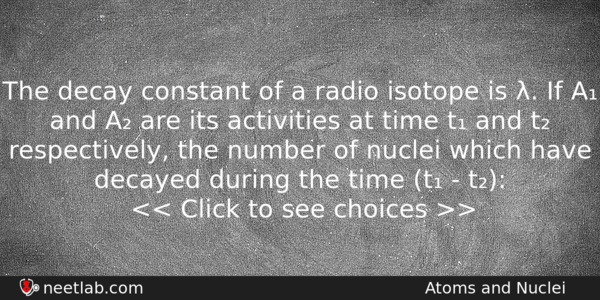| ⇦ | 
| ⇨ |
The decay constant of a radio isotope is λ. If A₁ and A₂ are its activities at time t₁ and t₂ respectively, the number of nuclei which have decayed during the time (t₁ – t₂):
Options
(a) λ (A₁ – A₂)
(b) A₁t₁ -A₂t₂
(c) A₁ – A₂
(d) (A₁ – A₂) / λ
Correct Answer:
(A₁ – A₂) / λ
Explanation:
Activity is given by A = dN/ dt = -λN
Activity at time t₁ is A₁ = – λN₁
and activity at time t₂ is A₂ = -1 N₂ as t₁ > t₂ therefore, number of atoms remained after time t₁ is less than that remained after time t₂.
That is, N₁ < N₂. number of nuclei decayed in (t₁ - t₂)
= N₂ - N₁ = (A₁ - A₂) / λ
Related Questions: - Surface tension of a solution is 30 x 10⁻² N/m. The radius of the soap bubble is 5 cm
- For photoelectric emission to take place
- A particle having a mass of 10⁻² kg carries a charge of 5 x 10⁻⁸C
- A wire of resistance 4 ohm is stretched to twice its original length.
- The material suitable for making electromagnets should have
Topics: Atoms and Nuclei
(136)
Subject: Physics
(2479)
Important MCQs Based on Medical Entrance Examinations To Improve Your NEET Score
- Surface tension of a solution is 30 x 10⁻² N/m. The radius of the soap bubble is 5 cm
- For photoelectric emission to take place
- A particle having a mass of 10⁻² kg carries a charge of 5 x 10⁻⁸C
- A wire of resistance 4 ohm is stretched to twice its original length.
- The material suitable for making electromagnets should have
Topics: Atoms and Nuclei (136)
Subject: Physics (2479)
Important MCQs Based on Medical Entrance Examinations To Improve Your NEET Score
18000+ students are using NEETLab to improve their score. What about you?
Solve Previous Year MCQs, Mock Tests, Topicwise Practice Tests, Identify Weak Topics, Formula Flash cards and much more is available in NEETLab Android App to improve your NEET score.
Share this page with your friends

Leave a Reply